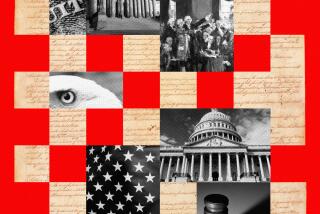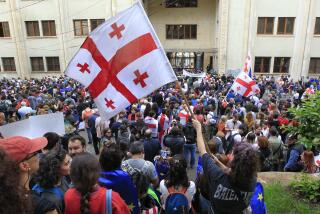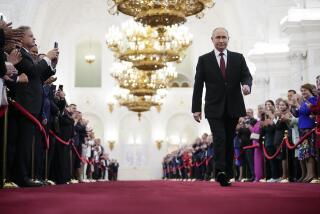Next Step : A Nation of Law, at Last? : After 75 years, Russia is again trying to forge a Western-style constitution. A troubled history is not on its side.
- Share via
MOSCOW — The czar had abdicated and the Bolsheviks were advancing. Hoping to save the day with a more liberal constitution, the provisional government called national elections for a constituent assembly to rewrite Russia’s basic law.
Two weeks before the vote, the Bolsheviks seized power . They allowed the elections to take place but failed to win a majority. And as the assembly convened Jan. 5, 1918, it loomed as an obstacle to V.I. Lenin’s dictatorship.
The gathering in Petrograd lasted 12 chaotic hours. Amid bitter debate, Bolshevik sailors guarding the 463 delegates teasingly aimed rifles at the rostrum, clicking back the hammers. Bolshevik delegates walked out.
At 4 a.m., the guard commander ordered everyone else to leave “because the guards are tired.”
“The members of the constituent assembly are also tired,” protested the chairman. “But no fatigue can disrupt our proclaiming a law awaited by all of Russia.”
The commander was not impressed. “The guards are tired,” he repeated firmly. “Please leave the hall.”
The next day, Lenin decreed the assembly closed.
“The toiling masses have become convinced that bourgeois parliamentarianism is outdated,” he declared.
*
Liberal reformers get few fleeting opportunities in each century to modernize this sprawling nation and its despotic ways. Next week, 75 years after the last, tragicomic effort to produce a viable Western-style constitution, they will have another shot.
President Boris N. Yeltsin has summoned 250 delegates--two from each of Russia’s 88 administrative subdivisions, the rest from political parties, social movements and business organizations--to Moscow on June 5 to adopt a legal blueprint for the post-Communist era.
A month after winning a popular vote of confidence in his presidency, Yeltsin is focusing his energy on this assembly, hoping it will sweep away two Communist-era obstacles to his liberal program--the Congress of People’s Deputies and the constitution that awards Congress supreme power.
Key legislative opponents of the president, after insisting that his constitutional draft must past through Congress, have grudgingly recognized the special assembly and put forward their own draft, which looks more like Yeltsin’s than the current Constitution.
Yet it is far from certain that Russia will emerge from this process with the strengthened presidency, streamlined two-house legislature and checks and balances that both drafts envision. The 1,033-member Congress and its imperious chairman, Ruslan I. Khasbulatov, are unlikely to self-destruct without a fight.
And even if all this happens, the assembly faces a more daunting task--deciding how Moscow is to govern a huge multiethnic federation of restive republics, regions and territories spread across 11 time zones, as the rigid mold of dictatorship and central planning melts away.
“The ideals of separation of powers and federalism as you know them in the West were never understood in Russia, much less practiced, because the law was never supreme,” said Alexander M. Yakovlev, a leading constitutional lawyer. “Here the law was a projection of czarist power, then Soviet power.”
The Process
Russia’s current constitution was drafted in 1977, under Soviet leader Leonid Brezhnev, and it never envisioned a president. On paper it gave power to the legislature, which was really meant to be a rubber stamp for decisions by the Communist Party leadership.
But after Yeltsin became Russia’s first democratically elected leader and the Communist system collapsed, the legislature and its deputies representing the military-industrial complex began to exert power to block his free-market reforms.
Shunning advice from radical allies to shut down the legislature, Yeltsin assumed the awkward task of working within the system he was trying to dismantle. Perhaps as a result, Russia has avoided the bloody civil strife and disintegration that many politicians make a ritual of warning against. But the country is adrift.
Victory in the April 25 referendum has allowed Yeltsin to seize the day, declaring himself the sole legitimate authority and moving to sidestep Congress.
“Either they back the course of the president and the government, or they will confront the people directly,” he said in a speech outlining his 133-article constitutional draft.
While Khasbulatov remains resistant to change, he has been undermined by his top deputy, Nikolai T. Ryabov, who accepted a job on the panel editing Yeltsin’s proposal for the assembly. Key figures on both sides voice support for the idea of merging the presidential draft and one being promoted by Oleg Rumyantsev, secretary of the legislature’s Constitutional Commission.
“It’s a question of Russia’s future, of parliament’s future,” Ryabov told the lawmakers in a pivotal speech that Khasbulatov testily interrupted several times. “Rejection of this presidential proposal would lead us directly onto a path of social confrontation.”
Yeltsin has left it unclear how the new constitution, once completed, will be ratified. But some of his advisers are saying that if Congress refuses to ratify it, Yeltsin may put the proposal before voters in a new referendum.
Separation of Powers
If Yeltsin is trying to throw off the yoke of a neo-Communist Congress, his critics see themselves as crusaders against the legalization of one-man dictatorial rule.
Vice President Alexander V. Rutskoi, who has turned on his boss, says that while reading the Yeltsin draft, “my impression is that I am looking at a coat that was hastily made to suit a particular figure.”
Even the president’s supporters are defensive about the “presidential republic” Yeltsin would create for himself and future heads of state.
Stanislav Shatalin, a leading economist with impeccable reform credentials, wrote in a lengthy analysis in the newspaper Nezavisimaya Gazeta that the Yeltsin draft “offers something strange and maybe even terrible.”
On the one hand, he said, it puts the prime minister in charge of the executive and appears as in France to set the president above the three branches of government. On the other, the president--not the prime minister--would name the Cabinet. The president could issue decrees, treading on the power of the legislature, and resolve disputes among the three branches, usurping a prerogative of the courts.
Not only that. The president would also appoint the justices of the highest courts and the commanding officers of the military. Only the nominee for prime minister could be rejected by the lawmakers, but if they did so the president could dissolve the legislature and call elections for a new one.
“The main problem with all this is the uncontrolled power of the executive,” says Rumyantsev, whose proposal offers a more even balance of powers. “No matter how beautiful a car might look, if it has no brakes, its fate is inevitable. It will crash.”
Regional Power
Advocates of the rival drafts are taking their struggle to Russia’s heartland, whose delegates will have most of the votes in next week’s assembly. But leaders nearly everywhere outside Moscow criticize both visions of the new Russian Federation.
Many cities, republics and regions have assumed control over their own economies and destinies in the past 18 months, making central ministries obsolete. Some have resisted such Yeltsin reforms as privatization of industry and free prices; others have moved at a faster pace than Moscow.
Tiny Chechenya, on the southern Caucasian rim, has virtually seceded. Tatarstan declared its “sovereignty” last year and refused to join the 87 other subdivisions in signing the Federation Treaty. Bashkortostan did so only after cutting a deal with Moscow to own all its oil. In Karelia there has been talk of rejoining Finland; in Kalingrad, rejoining Germany.
The big complaint out there is that the 1992 treaty, which calls for decentralizing political power and control of resources, is an empty shell. Russia’s semiautonomous “republics,” in fact, have much less autonomy than American states.
Yeltsin, who urged Russia’s subdivisions to “take all the sovereignty you can swallow” when he was fighting Soviet power, has included the Federation Treaty in his constitutional draft but contradicted its spirit by declaring “a unified system of executive power” throughout Russia.
Rumyantsev’s draft is just as controversial. It favors equal powers for Russia’s 88 subdivisions, ending the priviledged status that gives the 21 ethnic republics and oblasts--conquered territories on the periphery with just 17% of the population--half the seats in the legislature. Fearing separatism, Yeltsin wants to maintain this Soviet-created status quo, to the dismay of cities and regions in Russia proper.
The prospects for ethnic squabbling over this issue next week--with each side accusing the other of fueling separatism--are so alarming that many here believe it will be avoided and remain unsettled for years to come.
Rule of Law
The magnitude and complexity of Russia’s transition--from communism to capitalism, dictatorship to democracy, empire to federation--is unprecedented. It makes the history of America, which took a decade to adopt a constitution and then fought a Civil War to settle some basic constitutional conflicts, look simple by comparison.
What outside legal scholars find remarkable about the process here is that Russians--who never before had a government that obeyed its own laws, much less passed enlightened ones--are framing so much of the discussion about their future in legal terms.
“The debate is loud and nasty and it drags on slowly, but the general nature of it is encouraging,” said Sarah J. Reynolds, an expert on the Russian constitution at Harvard Law School. “They’re talking about how to legalize the most important institutions in the country.”
Equally notable about the debate is the heavy criticism of Yeltsin’s draft by many of his supporters.
For example, the president is taken to task for letting political expediency block his long-range vision. Why else, critics ask, would a leader at odds with his vice president eliminate the vice presidency for all time? And why would he keep such Soviet constitutional relics as “the right to employment” that contradict his vision of a free-market economy?
“If we could be assured that Yeltsin or somebody like him would be president for a long time, one would have no cause for dismay,” Vasily Selyunin, a pro-reform economist, told a pro-Yeltsin round-table discussion the other day. “But the constitution must guarantee preservation of democracy even under a (Vladimir) Zhiinovsky,” Russia’s best-known fascist.
St. Petersburg Mayor Anatoly Sobchak, a staunch Yeltsin defender, says Russia needs a strong president for the transition but not forever. Noting that Poland adopted a three-year constitution after emerging from communism, he thinks Russia should do likewise.
Mindful of Russia’s violent history, the president’s aides say the entire draft is open to compromise. Yet, in the same breath, they warn that this opportunity to reform Russia is rare and must not be lost.
“We must not discuss endlessly,” said Sergei M. Shakhrai, the 37-year-old legal strategist leading the campaign for Yeltsin’s constitution. “The system we are trying to get out of has tremendous potential for regeneration.”
Three Constitutions
Here are major differences among Russia’s current Constitution, drafted in 1977 under Soviet leader Leonid Brezhnev; the proposal by President Boris N. Yeltsin and the proposal by the Supreme Soviet’s Oleg Rumyantsev.
*
RIGHTS
Current Constitution: Gives greater prominence to rights of the state as collective owner than to individuals. An individual has no guaranteed right to own land.
Yeltsin proposal: Guarantees civil liberties and property rights, including the right to buy and sell land.
Rumyantsev proposal: Gives state responsibility to regulate economic life. Allows private ownership of land but imposes restrictions that block the breakup of collective farms.
PRESIDENCY
Current Constitution: The president is subordinated to the Congress of People’s Deputies, which can remove him. He cannot disband Congress. Many of his Cabinet appointments, including prime minister and minister of defense, are subject to Supreme Soviet confirmation.
Yeltsin proposal: The President is highest official in Russia. There is no Vice President. Under certain conditions he can disband the legislature and call election of a new one. He can be removed by the legislature if charges are confirmed by the Supreme Judiciary. He appoints the entire Cabinet; only the prime minister’s nomination subject to legislative confirmation. Rumyantsev proposal: The President heads the executive branch in a “parliamentary republic.” He may be removed by the legislature, but he cannot disband it. He must submit his nominations for approval by the chairman of the legislature. The president cannot issue decrees. He cannot declare a state of emergency without legislative consent.
LEGISLATURE
Current Constitution: The Congress of People’s Deputies is the supreme power in Russia. It can change the Constitution or remove the president. The Supreme Soviet, a smaller body drawn from its ranks, has strictly legislative powers.
Yeltsin proposal: The legislature is called the Federal Assembly. An upper chamber, the Council of Federation, represents Russia’s 89 regions and republics, with half the seats reserved for so-called ethnic republics that make up 17% of the population. It can declare war, approve key appointments, make constitutional amendments and vote on removing the president. A lower chamber, the State Duma, representing election districts with equal population, initiates legislation.
Rumyantsev proposal: The legislature is called the Supreme Soviet. An upper chamber, the State Duma, represents districts with equal population. A lower chamber, the Federal Assembly, has two deputies from each republic and region. The Supreme Soviet sets the main directions of foreign and domestic policy, may call referendums, declare war or a state of emergency, remove the president. Both houses may initiate legislation.
More to Read
Sign up for Essential California
The most important California stories and recommendations in your inbox every morning.
You may occasionally receive promotional content from the Los Angeles Times.













